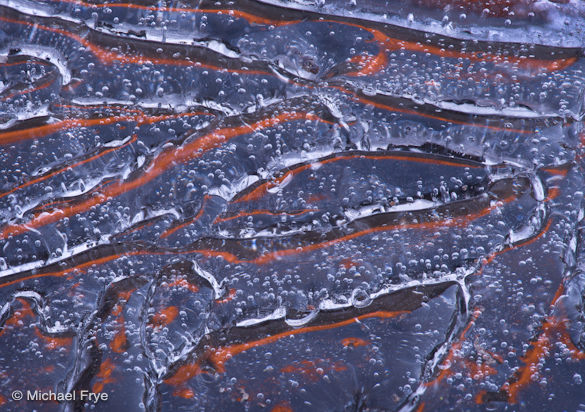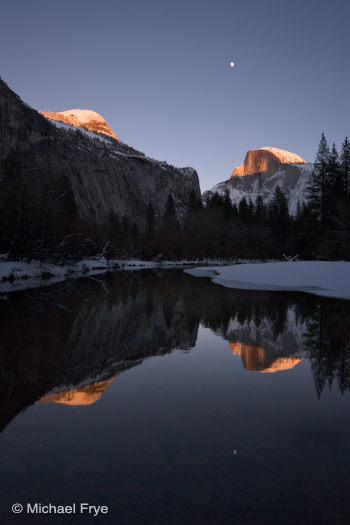It’s been a strange winter so far in Yosemite. Actually the word “strange” doesn’t do it justice—try weird, wacky, or even freakish. No measurable precipitation has fallen in Yosemite Valley since November 20th. There’s little snow in the high country, and the Tioga and Glacier Point roads are still open. The previous record for the latest closing date for Tioga Pass was January 1st, so with every snowless day that passes we’re setting a new record. And there’s no precipitation in the forecast for the next week.
But, as always, unusual conditions bring unusual opportunities. You can find interesting ice abstracts along Bridalveil Creek and the Merced River, like the one shown above that I made a few days ago while teaching a private workshop. And we have unprecedented access to the high country in January, and a chance to make some unusual moonrise images over the next few days.
In summer the full moon doesn’t rise near any Yosemite landmarks from the common vantage points. If you’re standing at Tunnel View in July, for example, the full or nearly-full moon will rise to the right, behind Cathedral Rocks or even further to the south. But in winter the full moon rises further north, and often aligns beautifully with Half Dome from many spots in Yosemite Valley, or between El Capitan and Cathedral Rocks from Valley View or Tunnel View.
And if you watch the full moon rise from Glacier Point in the summer you’ll see it appear over the Clark Range, far to the right of Half Dome. But with the Glacier Point Road open, it may be possible to see the moon rise just to the right of Half Dome from Glacier Point or Sentinel Dome.
Moonrise photographs usually work best one to three days before the actual full moon date. On the night of the full moon (like this Sunday), the moon rises at sunset, so by the time it ascends above cliffs and mountains of Yosemite the landscape is dark, and the contrast between the moon and everything else too extreme. But the moon rises, on average, 50 minutes later each day, so the day before the full moon it rises about 50 minutes before sunset, two days before about an hour and 40 minutes before sunset, and so on. This gives the moon a chance to ascend above the cliffs while there’s still light on the landscape—and beautiful golden light at that.
The best tool for determining the position of the moon is The Photographer’s Ephemeris, a free desktop application, or $8.99 for iPhone and iPad, or $4.99 for Android. Consulting TPE it looks like Saturday could be a good evening to catch the moonrise from Tunnel View, Glacier Point, or Mono Lake, and Sunday could also work for Mono Lake, where the horizon to the east is low enough that the moon should be visible right around sunset.
I may be at Glacier Point Saturday evening if the weather looks promising, so if you see me please say hello!
And a reminder: today is the last day to weigh in with your picks for my top images of 2011.
—Michael Frye
Related Posts: New Critique Tomorrow… and Tioga Pass is Open!; Moonrise and… Moonrise Again
Michael Frye is a professional photographer specializing in landscapes and nature. He is the author and photographer of The Photographer’s Guide to Yosemite,Yosemite Meditations, and Digital Landscape Photography: In the Footsteps of Ansel Adams and the Great Masters, plus the eBook Light & Land: Landscapes in the Digital Darkroom. He has written numerous magazine articles on the art and technique of photography, and his images have been published in over thirty countries around the world. Michael has lived either in or near Yosemite National Park since 1983, currently residing just outside the park in Mariposa, California.











Michael,
Great post concerning the possibilities that this year brings! Can’t make it up Saturday, unfortunately.
The view from Sentinel Dome might also be really nice on Saturday night. Different angle across to Half Dome (elevation) and a slightly different position of the moon in relation to HD.
Sorry I’m going to miss it!
Rick
Sorry you can’t make it Rick, but thanks for your thoughts on Sentinel Dome. It could indeed be a good spot.
Great shot and interesting post. I have been watching the weather reports ever since we have been down here (LA Area) since Dec 11 and have been waiting, hoping, that there will be some snow when we return north sometime after Jan 15. I see the 10 day is showing some clouds moving in, but still in the 50’s. Keeping my fingers crossed.
Aram
Thanks Aram. We’re all keeping our fingers crossed and hoping for some snow. It can’t stay like this forever, can it? Can it?
Went to the Cathedral area yesterday. I posted a moon shot from Lower Cathedral Lake (ON the lake…) on my Facebook page and the A.A.G. Facebook page: http://www.facebook.com/profile.php?id=528048610#!/photo.php?fbid=10150480801473611&set=a.10150478620328611.375212.528048610&type=1&theater
A strange, concerning, and facinating time (photo-wise) here in the park…
Kirk
Kirk, thanks for sharing the photo – it’s cool to see Lower Cathedral Lake frozen! And “concerning” is a good word…
Michael, thanks for the info on how to prepare for moonrises. Here in Colorado Springs the moon rises over the plains and sets over Pikes Peak and the Front Range. On my Andoid phone I use the free “Sundroid” app to get the times – seems to work fairly well. One comment: I notice that your shot has something in it that I have had problems with for many years. In my old Kodachrome and Ektachrome slide days whenever I tried to photograph the moon it almost always came out looking like someone just punched a hole in my slide. Since I did not have a camera that was capable of doing double exposures I could never get a good image of a textured moon with a good landscape below. I imagine that with today’s digital technology, HDR and/or extensive photoshopping this might now be possible. Can that be done without “importing” another image of the moon into a landscape? I would think that one might have a major problem with the reflection in any lakes doing it that way.
James, the better digital cameras these days have much better dynamic range than slide film, so that helps to retain detail in the moon in situations like this. See my video on “Lightroom HDR” for an example of this (click on Video Tutorials in the right-hand sidebar under Categories).
Also, the contrast between landscape and moon increases dramatically as the sun goes down, so if you’re trying to photograph the moon after sunset it’s virtually impossible to get detail in both the moon and landscape in one frame. So then you have to combine two exposures. This is something I do pretty frequently in such situations. I’ll bracket exposures, then take the best overall exposure for the scene into Photoshop and add some texture to the moon from another frame. Reflections are not an issue, since they’re two or more stops darker than the sky, so there’s usually plenty of detail in the reflected moon.
Michael, thanks for the tip. I’ll review the video tutorial and next time I’m out to “shoot the moon” I’ll incorporate your advice!
Great – good luck!
Hi Michael,
Thanks for the tips. They are grt, as always! I love the first photo- The red streaks look like molten lava. Great abstract !
Thanks Vidya – glad you like the photo!
I wish I were in California to take advantage of these unusual conditions! Here in Illinois the winter has been weird too. I was taking photos of an ice covered pond and it was in the 50’s.
I hope you get some interesting moon photos!
Thanks Vivienne – weird weather everywhere I guess!
Hi Michael,
I was up at Glacier Point tonight but thought I’d try a different vantage point, so I headed down the 4-mile trail a little ways and found a great view with both Half Dome and Glacier Point. Had the area to myself until 2 others showed up 🙂 Really amazing alpenglow and moonrise tonight–am really happy with having experienced it! Heard you were at the point so I can’t wait to see what you got as well!
Check out my shot on my Facebook photography page!
http://www.facebook.com/media/set/?set=a.394326051450.174348.113780021450&type=1&l=bbf08fcedc
Sorry I missed you Kristal, but it looks like you found a good spot, and got a very nice image – and the one with Half Dome and Merced River too. Were those two people who showed up Evan and Kirk from The Ansel Adams Gallery? I think they went down that way.
Yes, I believe it was them!
Boy this weather is strange . I know its still a little way away but with no snow in the forecast what do you think the chances are for Horsetail fall to be working this year Michael ?
Regards Duncan
PS. Just checked the 7 day forecast again. How are you enjoying the summer up there?
The summer is lovely, thanks! Horsetail is looking iffy. It could still happen if we get some snow storms in the next month, but I wouldn’t make any non-refundable reservations.
I’m still thinking of coming up around then Michael , I know last year you said that the window was a little later than normal (feb 12th -22nd) any idea what the window would be this year just incase we should get any snow?
Thanks Duncan
Just read your article a little more thoroughly and all is explained .
https://www.michaelfrye.com/articles/horsetail.html
Thanks Duncan
Great!